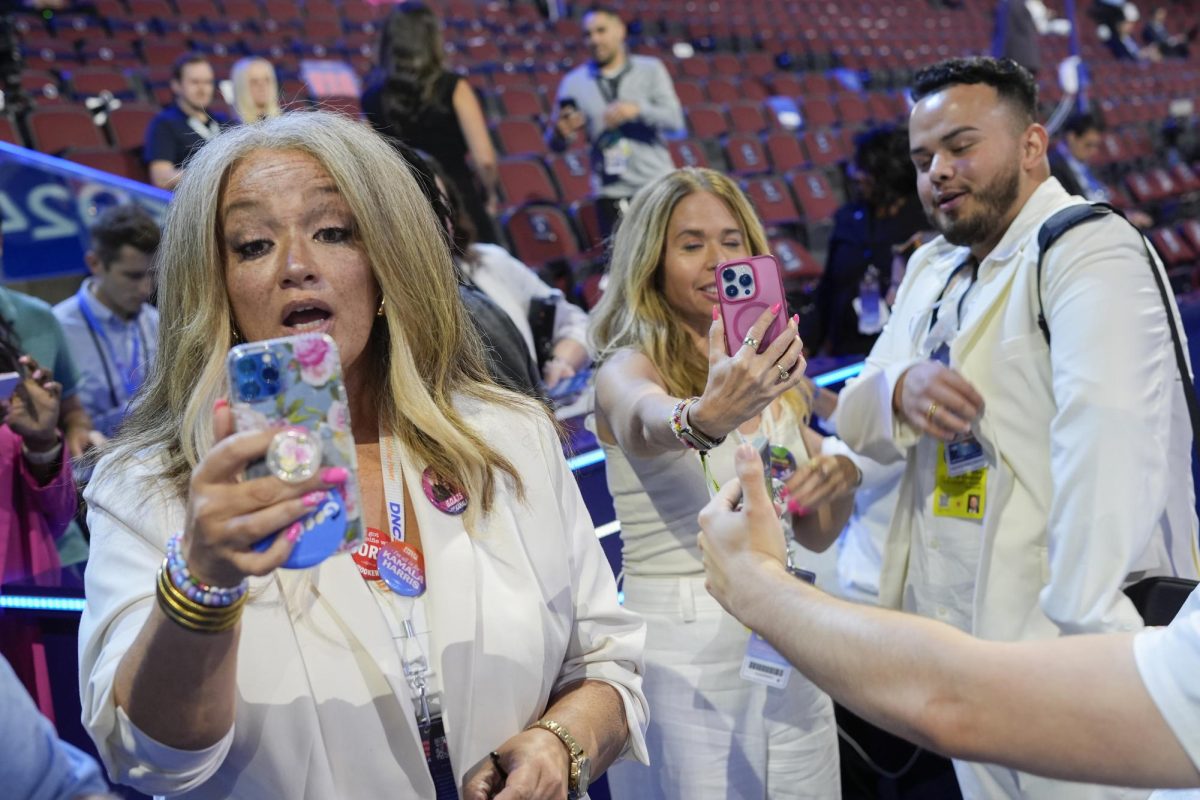Twenty-somethings who talk to their phones became a threat to seasoned journalists at the Democratic National Convention in Chicago last week. Traditional media outlets that have made miniscule efforts to connect to Gen Z seemed shocked to find that DNC organizers hungry for the youth vote favored influencers over their reporters.
The convention credentialed some 200 influencers to generate content in Chicago, according to Politico. They were given their own lounge inside the United Center, special access to speakers and room on the convention floor – permissions that nagged many of the 15,000 traditional journalists present.
Journalists’ views of the DNC looked more like nosebleed seats and limited floor access. Their lounge was a press tent outside the stadium.
The party’s obvious (and arguably successful) goal was to stump Harris to Gen Z voters via the iPhone cameras of 200 tech-savvy, opinionated and illustrious internet presences. The consequence: A lot of angry journalists.
And that’s exactly the problem in traditional media right now. It’s a lot of fear of the unknown, and a lot of anger when people turn to shinier methods of media consumption. Outlets rarely spare a thought to ask, “Why does Gen Z prefer TikTok stars with ring lights and skincare routines? What do they have that writers don’t?”
So, let’s spare that thought. Let’s contrast two opinionated responses to the convention – one from a traditional media outlet, and one from an influencer – and see what we come up with.
On Tuesday, New York Times Opinion ran a story called “Kamala Harris Has Left The Building,” a transcript of a conversation between conservative columnist Bret Stephens and liberal columnist Gail Collins. In it, they discussed Vice President Kamala Harris’ big acceptance speech in Chicago.
Let’s say I’m a Gen Z reader, largely apathetic to politics but interested in the hyped-up image of the DNC I’ve seen on TikTok. I want to hear what the professionals have to say about it, so I make my way to NYT Opinion, where Stephens and Collins’ conversation catches my eye.
But wait a minute, who even are these people, and why should I listen? I look up Stephens’ age, 50, and hesitate. I find out Collins is 78 and wonder how someone as old as my grandmother could comment on the DNC in a way that’s relevant to me.
I feel my attention span running dry before I’ve even opened the article. I close the tab. I’m on Instagram within seconds.
Now, let’s say I’m a Gen Z reader who does see some appeal. I open the story and read. Would I get past the terrifying “hehehe” spelled out repeatedly whenever the columnists laugh? Would I run away screaming the second I saw the word “doubleplusungood” used unironically? Is any of it worth the cringey reminders of generational divide?
And then, would the conversation even speak to me? After all, neither columnist seems particularly excited to be there. And neither really champions a candidate. Collins is pro-Harris in the lifelong Democrat, thank-god-it-isn’t-Biden way that gets drowned out by the sheer energy of the rest of her party. Stephens refutes Trump but would rather “cast a write-in ballot for Mr. Magoo” than vote for Harris.
It’s all fine and predictable and jargon-stuffed. But it feels bland – impossibly far from the eagerness and energy of the convention as we see it on our social media feeds, slotted into a gray area between what political energy used to look like and what it has become.
What it has become is lively, fresh and social-media ready. Sensationalized? Maybe a lot. But it’s undeniably fun. And traditional publications can’t seem to keep up.
Let’s turn now to Henry Sisson, an 21-year-old influencer with more than 1 million followers on TikTok.
On Aug. 22, 2024, Sisson posted a TikTok of himself reacting to Harris’ acceptance speech, minutes after the vice president walked off stage. In it, he talks into the camera from high in the stands with the DNC floor visible below him.
He’s engaging, to say the least. His words are uplifting and simple — easy to understand. His hands move wildly with excitement.
“Folks, Kamala Harris’ speech just ended. There are balloons everywhere. We’re all losing our voice,” Sisson said in the clip. “She talked about the issues that matter to the American people … Kamala Harris needs to be the next president of the U.S. Our country literally depends on it.”
But a TikTok isn’t the same as an op-ed, you say. They’re apples and oranges! They shouldn’t be compared.
Sure, the two may look different, but there’s an argument in Sisson’s clip that makes it worth comparing to opinion writing. His words may be simple, but so much is communicated in background details like the whooping crowd he has to raise his voice to talk over, and the hype music echoing around the United Center. There’s rhetoric in his smile, his wide eyes and his hopeful tone.
In several hundred words fewer, he’s saying what several columnists have said since the DNC ended: Joy can be an infectious political weapon.
More importantly to Gen Z, Sisson makes watchers feel like they’re part of the story — not just reading it.
Young people want to feel like they’re not by themselves in believing whatever they believe. They want irony, humor, enthusiasm and to be understood. They see through aloofness and resent unnecessary complexity. They like hearing their news through other people’s mouths, despite the dangers of misinformation.
According to the American Press Institute, 71% of Gen Z and Millennials get news from social media platforms at least daily. That number isn’t going down unless publications stop resenting influencers and start learning from them – especially where opinion work is concerned.
Stories end, but scrolling is forever. Let’s hope the DNC was the wake-up call American journalism needed.


